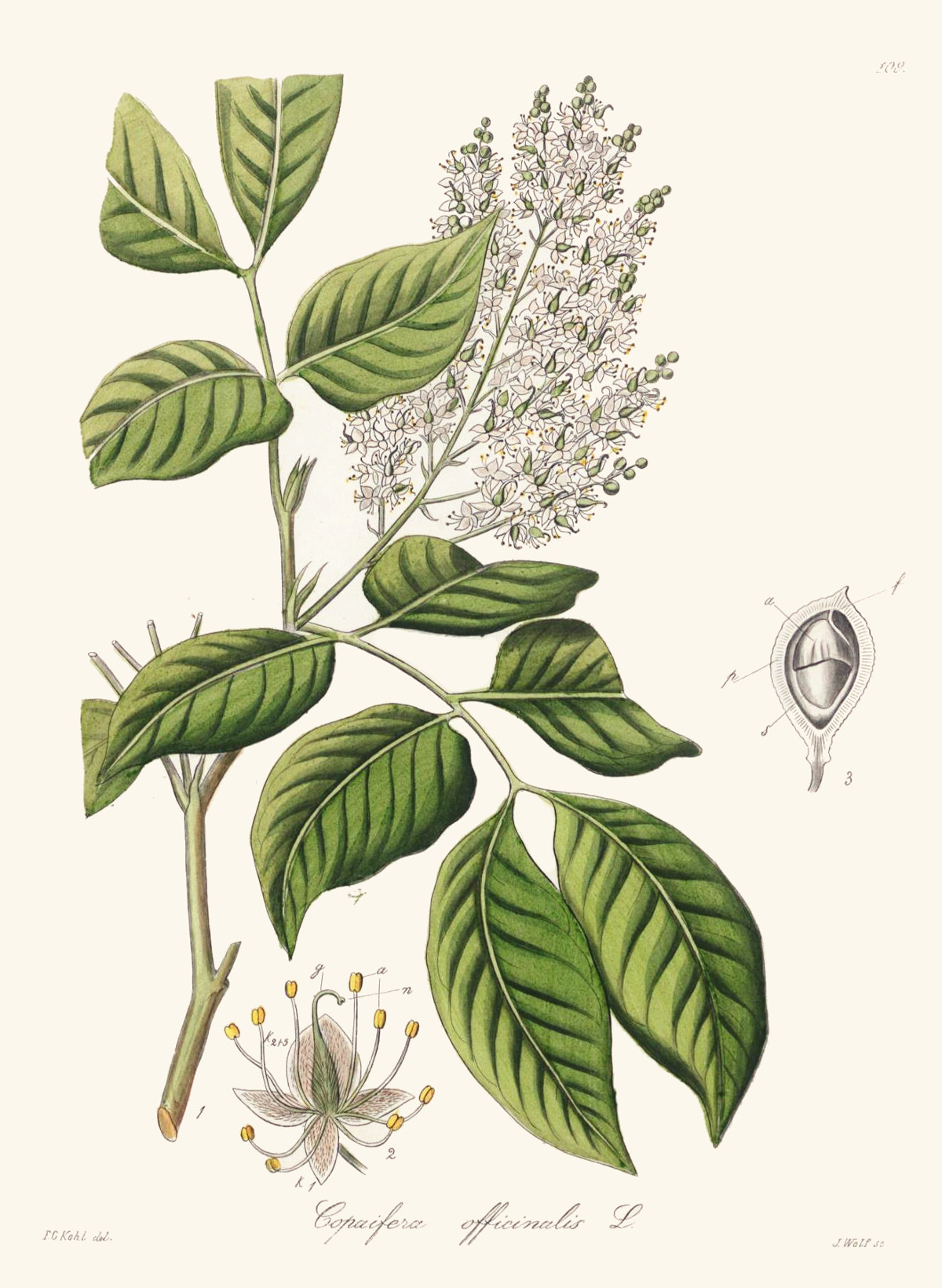Copaifera officinalis (Jacq.) L. - Fabaceae - copaiba (tree), diesel tree, Balsamkopal-Baum, Copaiba (-Baum)
Branchy tree, up to 30m high, native to Amazonas rainforests; source of copaiba oleoresin (obtained from the trunk, also of several other Copaifera L. species, like copaifera_multijuga_hayne and copaifera_langsdorffii_desf e.g.
„The leaf tissue contained 26 sesquiterpenes and the stem tissues contained 25 sesquiterpenes. Two sesquiterpenes were identified in roots. The most abundant sesquiterpene in leaves was germacrene D with a concentration of 322.8 mg/g fresh weight, which accounted for 81.4% of total sesquiterpenes. Germacrene D was also the most abundant sesquiterpene in stems, which had a concentration of 256.2 mg/g fresh weight. Four terpenes, including α-cubebene, cis-α-bergamotene, trans-α-bergamotene and sesquisabinene-B, were
only detected in leaves but not in stems. α-gurjunene, β-selinene, and α-calacorene were only detected from stems, but not leaves. Twenty-two sesquiterpenes were detected from both leaves and stems. (E)-β-caryophyllene was the only compound that was detected from all three organs: leaves, stems, and roots. The other compound detected from roots, α-gurjunene, was also detected from stems. The concentrations of all sesquiterpenes in leaves, stems and roots of young seedlings were 396.3 mg/g fresh weight, 353.15 mg/g fresh weight, and 1.2 mg/g fresh weight, respectively.“
[Within-plant distribution and emission of sesquiterpenes from Copaifera officinalis., Chen, F., Al-Ahmad, H., Joyce, B., Zhao, N., Köllner, T.G., Degenhardt, J., Stewart, C.N., Plant Physiology and Biochemistry, 47(11), 2009, 1017-1023]
http://plantsciences.utk.edu/pdf/chen_stewart_PLAPHY2879.pdf
„Copaiba oleoresin is widely used as a popular medicine, through topical and oral administration. It has various ethnopharmacological indications, including: gonorrhea, bronchitis, pains in general, back pain, injury, blennorrhagia, leucorrhea, psoriasis, “catarro da bexiga”, wounds, asthma, as an antiseptic for wounds, skin ulcers, aching joints, ovarian cysts, uterine myoma, weak uterus, vaginal discharge, ovarian problem, ulcers, sore throat, uterine infections, general inflammations, as a tonic and to treat ulcers and other digestive diseases, and cancer, and leishmanioses…
The perfume and cosmetics industries have shown great interest in the sesquiterpene fraction, which is responsible for the aroma of copaiba oleoresin. The commercial value of concentrates of sesquiterpenes of Copaifera is as much as six hundred times higher than that of the whole copaiba oleoresin…
Chiral GC-O-MS proved (+)-δ cadinene to be the only enantiomer present in the oleoresin, with a sweet, green, refreshing aroma.“
[Chemistry and biological activities of terpenoids from copaiba (Copaifera spp.) oleoresins., Leandro, L.M., de Sousa Vargas, F., Barbosa, P.C.S., Neves, J.K.O., da Silva, J.A., da Veiga-Junior, V.F., Molecules, Vol.17(4), 2012, 3866-3889]
http://www.mdpi.com/1420-3049/17/4/3866/htm
Main volatile components of a commercial copaiba oil (Brazil, 2018) were β-caryophyllene (38.5%), germacrene D (12.6%), α-caryophyllene (5.2%), α-copaene (5.2%), δ-cadinene (4.5%), β-bisabolene (2.9%), γ-muurolene (2.2%), δ-elemene (1.3%), and β-selinene (1.0%).
"Balsam Copaiba Oil" aromatics.com GC/MS provided, retrieved 2018-10-07.

Kohl, F.G., Die officinellen Pflanzen der Pharmacopoea Germanica, t.109 (1891-1895)
http://plantgenera.org/species.php?id_species=272285